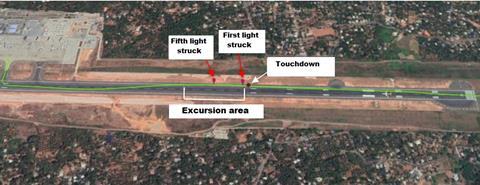Several runway lights were damaged by an Etihad Airways Airbus A320 after it drifted from the centreline during an approach in darkness and poor weather to Kozhikode airport in India.
The United Arab Emirates’ General Civil Aviation Authority says the crew had already executed a go-around during the initial approach to runway 28, owing to heavy rain, as it arrived from Abu Dhabi on 20 June last year.
Intense rain was also present during the second approach. The runway did not have centreline lighting and the inquiry says the rain, despite the windscreen wipers, blurred the captain’s view of the runway edge lights.
The aircraft had been stabilised at 1,000ft, the investigators state, and remained on track until it crossed the threshold, whereupon the captain applied “several” right-roll inputs – leading to a continuous right roll for about 8s, with a roll angle of up to 4°.
This caused the A320 to drift to right of the centreline. “The [captain] was focused more on the aircraft pitch attitude during the flare, since he was confident that the aircraft was aligned on the runway centreline when it was above the threshold,” says the inquiry.
Without centreline lighting, however, the captain’s ability to judge the A320’s position was affected, and the investigation believes he unintentionally applied the right-roll commands because he testified that he did not feel the aircraft bank during flare.

The flare was intentionally long, owing to the high aircraft weight of 64t and the runway up-slope, and the drift was probably exacerbated by a slight crosswind component from the left.
Although the captain realised the aircraft was on the right-hand side of the runway at about 15ft, he opted to apply left rudder input, rather than left roll, to recover. The rudder input shifted the aircraft’s drift angle to the left but made no significant change to the lateral deviation.
“Use of left rudder only, without left lateral input…did not allow for an easy re-alignment back to the centreline before touchdown,” says the inquiry.
Runway 28 is 45m wide. The jet touched down 910m beyond the threshold, some 14.5m to the right of the centreline, its nose 8° left of track, and started striking runway edge lights less than 1s later.
Five lights were hit. The aircraft recovered to track parallel to, and slightly left of, the centreline about 1,500m beyond the threshold. Subsequent inspection revealed tyre damage to the jet (A6-EIT) but none of the 124 occupants was injured.
No cockpit-voice recorder information was available to the inquiry, because measures to preserve the recording were not carried out immediately after the crew became aware of the lighting damage.
The first officer claimed he had been aware of the drift, but did not attempt to draw the captain’s attention – contrary to standard procedures which require the monitoring pilot to call out any destabilisation.
Investigators state that the first officer was half the captain’s age with about a tenth of the captain’s total flying time. Among the inquiry’s recommendations is for Etihad to enhance crew-resource management training by putting particular emphasis on the need for assertiveness.


























